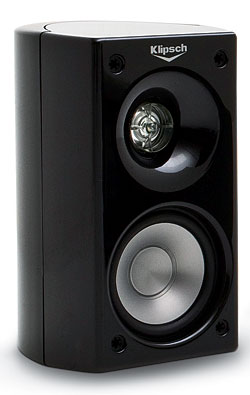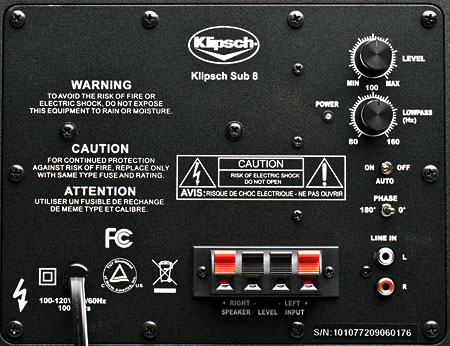Klipsch HD Theater 500 Speaker System Page 2
 The Blu-ray release of The Love Guru has a surprisingly soft-focused and rolled-off Dolby TrueHD soundtrack. It reminded me of the linear stereo soundtrack from a VHS tape. Nonetheless, I managed to catch all of the dialogue at a fairly low level without fiddling with the master volume control.
The Blu-ray release of The Love Guru has a surprisingly soft-focused and rolled-off Dolby TrueHD soundtrack. It reminded me of the linear stereo soundtrack from a VHS tape. Nonetheless, I managed to catch all of the dialogue at a fairly low level without fiddling with the master volume control.
Wood and Steel and Real Singing
I bought 4 Way Street by Crosby, Stills, Nash & Young when it was released in 1970, placing this 39-year-old gatefold double-live LP somewhere in my first 50 record purchases. Half unplugged (before that became fashionable) and half electric, it was recorded in the days when musicians played acoustic guitars in front of microphones, with no electronic pickups, so the true wood-body and steel-string character of the instruments came out. Those were also the days before pitch correction, so when Graham Nash reached for a hearty high yelp in “Chicago” and didn’t quite make it, you got the real thing, the passionate human belting it out on stage, not some digital fakery.
The MicroTractrix-horned satellites beamed this audio vérité straight into my head. They managed to pull a satisfying amount of detail out of the somewhat reverb-heavy recording, although the beaminess became obvious when I moved about the sofa. It was more noticeable in Dolby Pro Logic II music mode, when the beams were closer together, than when I shut down the center for two-channel listening. A civilian probably wouldn’t notice the effect, and it certainly didn’t detract from my moving reunion with Neil Young’s youthfully supple high tenor and Steve Stills’ lusty rasp. However, it was the C in CSNY, David Crosby, who emerged as the star of the reunion. His life has been a vast catalog of dissipation, and “Triad” seems to be an attempt to talk some hapless woman into a ménage à trois. But whatever his character flaws may be, he had the guts to sing quietly, charging his performances with limpid beauty and gorgeous near-silences, the stuff of candles guttering in a darkened room.
The Klipsch system cast a golden glow over Return to Forever’s No Mystery LP, confidently conjuring the Latin warmth and quirky intensity of Chick Corea’s various electronic keyboards without letting them declaim too stridently. Corea favored a bright sound even when he switched to grand piano. The speakers did not disguise this tendency, but they did keep it in check. While the sub could only hint at the roiling sea of Lenny White’s kick drum and Stanley Clarke’s bass, it still had enough rhythmic snap to sketch out the drummer’s bubbling snare. The highlight of the album was the non-amplified half of side two, where piano, acoustic guitar, and string bass pull together in rapid-fire unison playing, lucidly focused MicroTractrix-style.

I have not seen the film La Sconosciuta—there’s no Region 1 DVD or Blu-ray release—but I have heard the CD of Ennio Morricone’s soundtrack. The movie’s reportedly dark meditation on the female side of the human condition gets a complementary treatment for string orchestra, with occasional incursions by guitar, bass, and drums. Morricone managed to evoke Bernard Herrmann, Philip Glass, Brian Eno, and of course himself in a vibrant and harrowing emotional terrain. Dolby Pro Logic II’s treatment of the strings, including various soloists, gave the Klipsch speakers a chance to throw out a large soundfield.
Horned Demons
The Klipsch HD Theater 500 satellites are as good as any horned satellite speakers I’ve ever heard. If that sounds like I’m hedging, I’ll add that they’re among the best satellites I’ve ever heard in general. In fact, the well-sculpted midrange they delivered with my trusty old Rotel AVR was better than what I’ve heard in at least 85 percent of the demo rooms at high-end audio trade shows. At these shows, five-figure system price tags are no insurance against obvious coloration and/or alarming listening fatigue. I make this kind of statement to counter the widespread myth that surround gear is a distant second best to atrociously priced two-channel—not to mention that other myth that you can’t buy anything decent for less than $1,000.
The Sub 8 does a good job by the standards of this price point. However, the sats outclass the sub, and they do a far better job of disciplining and focusing the midrange than the sub does at disciplining and focusing the bass. If I owned this set, I’d relegate the sub to second-sub status and add something with a bit more low-bass punch and upper-bass finesse to cover the high crossover.
The fact that I’d even think about what I’d do with the Klipsch HD Theater 500 if I lived with it should tell you something.

- Log in or register to post comments




































































